Analysis: How the Exeter Chiefs are revolutionising the wing position

It is often said that Jonah Lomu changed the game in more ways than one. He became the game’s first global superstar in 1995 but also become the first of his kind on the wing, a gigantic 120kg powerhouse that clocked 100 metres in under 11 seconds.
It was the vision of the All Black selectors at the time that foresaw the potential the No.8 could have on the edge. In a bold move, the All Blacks moved the back-rower into the wing position where he had never played before professionally.
It was a mismatch dream as Lomu destroyed opposition wingers physically, who were outmatched by 30 odd kilograms. Lomu became an Icon and power wingers became the new norm, paving the way for the likes of Tuquri, Savea and Nadolo.
In the English Premiership, Exeter Chiefs’ wingers are undergoing their own evolution, albeit with slightly less profile but no less fascination. Jack Nowell and Olly Woodburn play like no other wingers in World Rugby.
X-Wings
Exeter’s wings are being used in ways wingers never have in the modern game – at least not to this extent. Arguably no team has deliberately expanded the role of the wing like Exeter, moving away from a traditional finisher in favour of a roaming gadget man. It has become a multi-position role at the Chiefs – the wingers spend more time off the edge than on it in phase play.
Other wingers may roam, but they are rarely afforded primary playmaking duties. Exeter’s pair are deliberately positioned in attacking play to provide ball playing, requiring far more cerebral decision-making than usual, as well as a superior passing game typically absent with wingers.
They perform like a hybrid first five-eighth/fullback/centre – utilising the skills they have from playing these other positions. They bounce between first receiver and wider roles looking to inject in three-on-two or four-on-three situations. At times, they even link up with each other.
This in itself is remarkable – many wingers end up as wingers due to one-dimensional skillsets. The reverse is true at Exeter, the more versatility you have as a winger the better. The Chiefs system will find ways to maximise it.
With the dissemination of forwards and backs in modern 1-3-3-1 and 2-4-2 structures, wingers at times do find themselves inside forwards with the big men outside on the edge. The Chiefs have taken this to another level, with almost all the players from 10 to 15 interchangeable in phase play.
Screen passing is integral to Exeter’s structure, outside of a basic pod, almost every phase wide through the hands utilises screens to get the ball to the versatile backs. We then see noticeable patterns of play that form when reviewing Exeter’s play.
The Reload-Switch
Exeter’s halfbacks Will Chudley and Nic White are constantly scanning the short side defence line looking for an opportunity to run this pet play – a switch screen pass after a quick reload.
After spreading wide into the 5m channel, play is brought back towards the middle with a simple forward runner off 9. The players involved in the previous ruck attempt to ‘reload’ as quickly on the short side as possible to be available for a switch play.
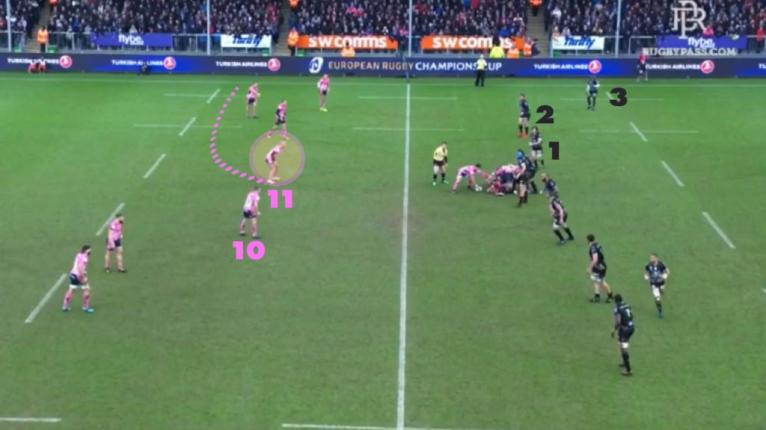
Woodburn (11) will travel from his sideline to station directly behind the latest ruck. This gives the Exeter winger two options.
If the halfback decides to continue the same way to the open side, Woodburn will run a support line giving his 10 an inside option outlined below.
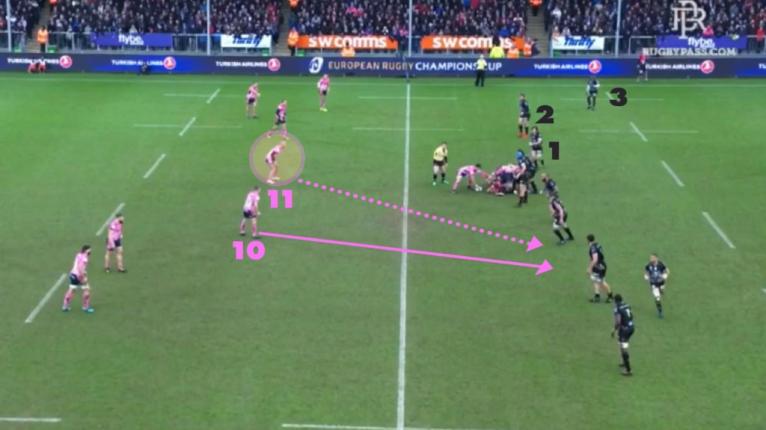
If the halfback sees an opportunity to play numbers on the short side, Woodburn then becomes the first receiver, receiving the ball behind the decoy runner on a screen pass and attacks the line with a three-on-two opportunity.
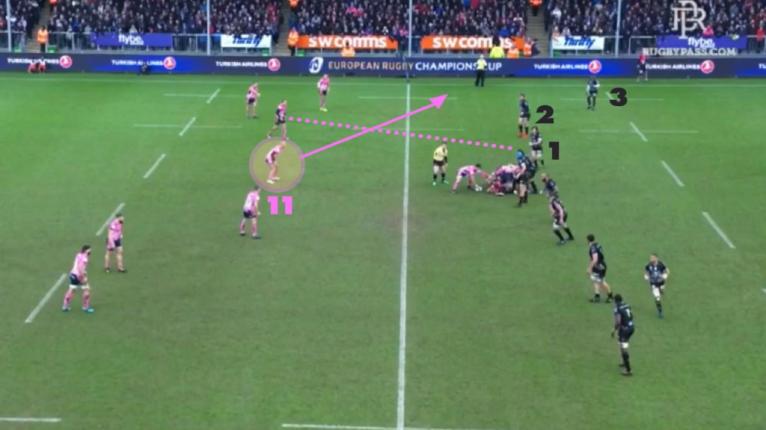
This set up is very typical of Exeter play and a perfect example of the quasi-back role that is expected of their wingers. Woodburn is deliberately injected into the play as a ballplayer in the second variation which is generally foreign territory for a winger.
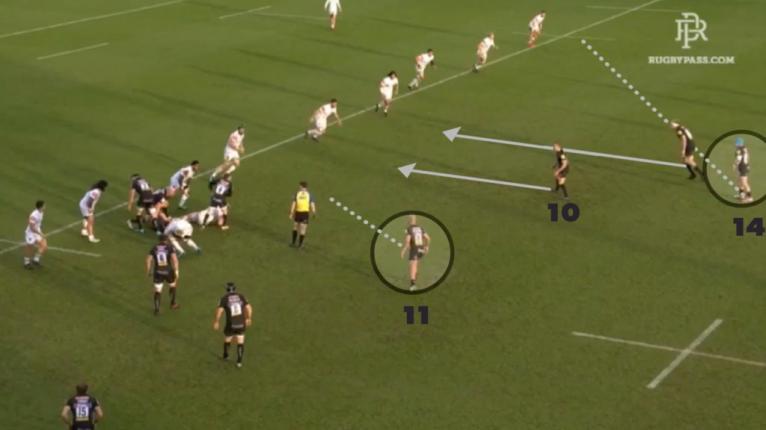
Here we see the same setup from the reverse angle. Woodburn is stationed behind the ruck ready for either option. The forwards on the left short side, however, have not reloaded in time in this instance.
We also see Exeter’s right winger, Jack Nowell (14), positioned as a backdoor option in the middle of the field much like a mid-fielder or fullback.
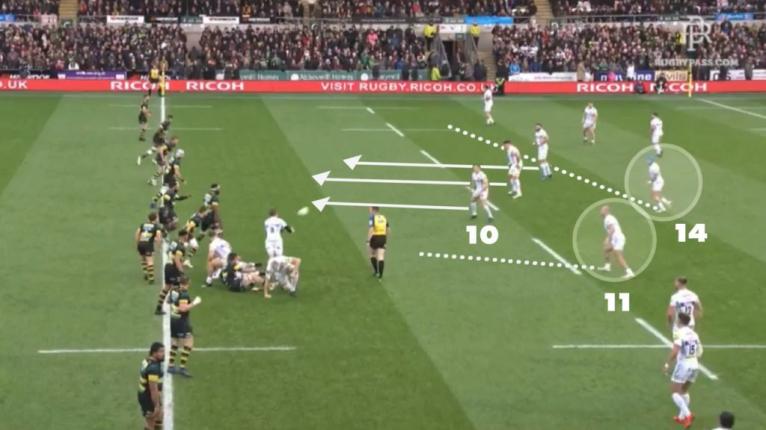
As we see with the above examples with Jack Nowell (14), the winger works his way to the midfield to be a part of the next open side attacking phase. He can be used as a playmaker, either running the screen or be the recipient of the screen pass out the back.
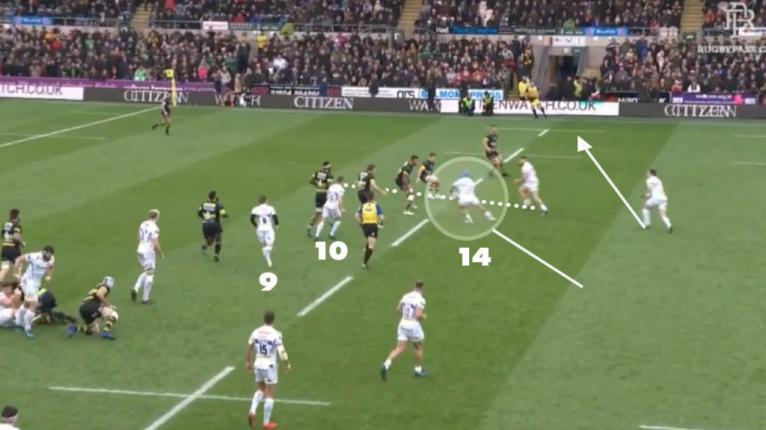
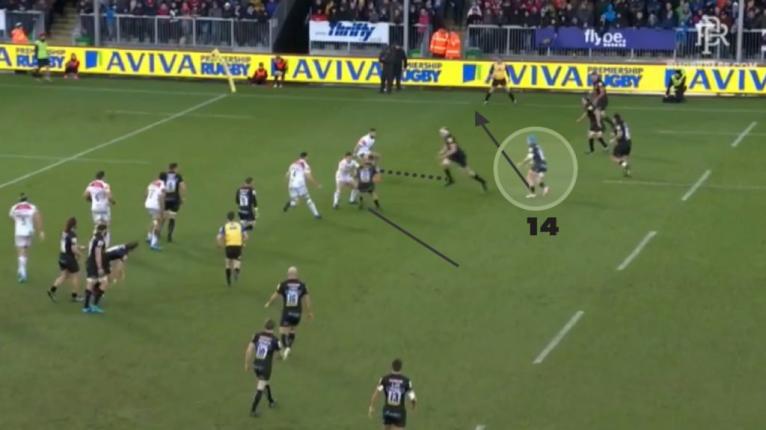
Nowell injects into the line like a fullback looking to free up his outside men. The fleet-footed winger often uses his elusive running game in this situation, taking advantage of sliding defenders trying to cover the overlap.
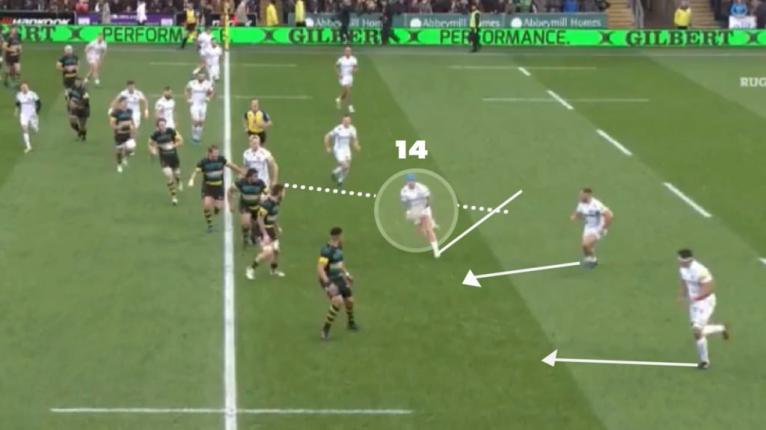
Both Nowell and Woodburn find themselves frequently tasked with exploiting numbers on the edges behind screen plays, playing the role that a centre or fullback typically would.
If Exeter stretches too wide towards the touchline, they settle play and repeat the process, teasing the short-side whilst planning another wide raid.
Set-Piece and Defence
The wingers find themselves playing more traditionally in defence, stationing the edges, dropping back to cover kicks and fielding bombs in the air. Woodburn, in particular, is excellent at defusing aerial raids.
During set-piece plays, they may perform various roles but do find themselves with the familiar task of finishing. Woodburn scored two acrobatic tries in the corner against Montpellier on the weekend, going one-on-one with his opposite on the edge after spending most of the match roaming around.
The multi-purpose winger
Exeter’s special duo enables the team to diversify the playmaking duties, spread the key backs across the park in many different variations and work for mismatches.
Yet for all the versatility, the wingers must still possess the necessary skills to play wing traditionally – kick coverage awareness in defence, ability to defuse high balls and athleticism to finish one-on-one chances.
The multi-purpose winger requires a player with a rare skill set and the specific system to match, which Exeter currently have. Nowell has spent time growing up as a fullback and outside centre, while Woodburn also has experience at outside centre. Instead of shelving these skills learned in other positions, Exeter has encouraged the use of them, evolving the wing position in the modern game.
Whether this trend will grow or not remains to be seen, but if Exeter continues their successful run, there will surely be others looking to replicate and find value with the versatile winger.












































